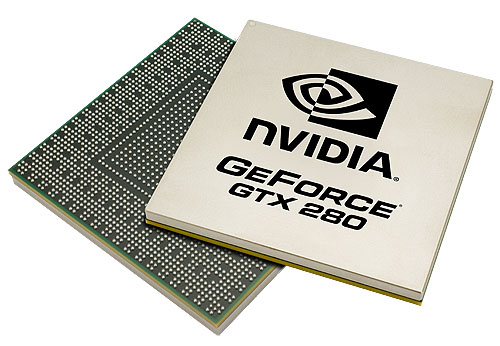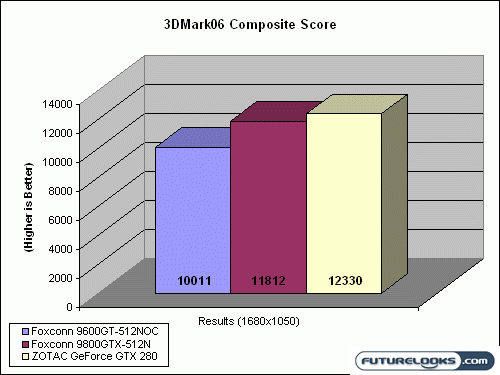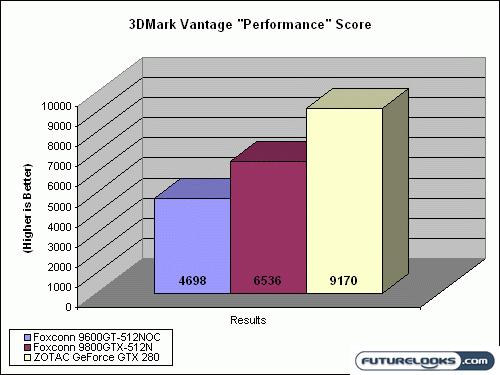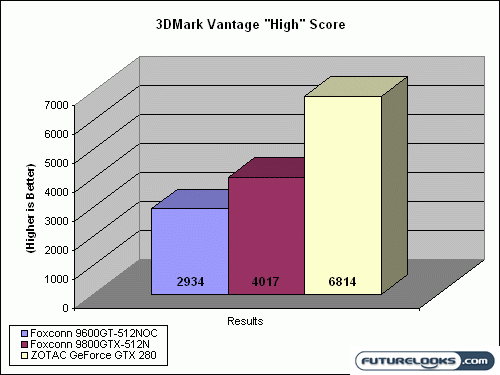Heart of the Matter

There’s also the main GPU core, which by all accounts is rather large. This is due by and large to the heat spreader NVIDIA installed. Still I’m left wondering how large the core underneath is. Power regulation is taken care of by a complex system of transistors and solid state capacitors. Like the 9800 GTX we reviewed, the GeForce GTX 280 doesn’t chintz out by using electrolyte based capacitors. Now we just need to see how this card performs against our previously reviewed video cards.
Testing
Now the fun begins. We get to test and see how well the ZOTAC GeForce GTX 280 stacks up against the cards I’ve previously reviewed. Here’s the rig we threw together to test out this new behemoth of a video card.
- AMD Phenom 9850 2.5GHz Quad Core CPU
- Asus M3A32-MVP Deluxe/WiFi-AP 790FX Motherboard
- OCZ Platinum XTC REV.2 PC2-6400 2GB 2X1GB DDR2-800 Memory Kit
- Western Digital 640GB Caviar SE16 7200rpm SATA2 Hard Drive
- Thermaltake DuOrb CPU Cooler
- NZXT Tempest Midtower ATX Case
- Thermaltake Toughpower 1000W Power Supply
- Microsoft Windows Vista Ultimate SP1
For testing we first ran 3DMark06 and 3DMark Vantage. This gives us a base line to go from when flowing into the gaming tests. Due to some problems with our Supreme Commander test, the testing for the ZOTAC GeForce GTX 280 is going to be rather heavy with first person shooters. Normally we’d also test acoustics, and see how loud the card is. However that was a bust, as the readings I got from my sound meter weren’t any different then those of the tests performed with the same case containing a 9800 GTX. So…let’s see how well this card chews through polygons.

First up in our round of synthetic benchmarks is 3DMark06. Though this benchmark is starting to become antiquated, this tool is still useful in determining the DirectX 9 performance of a video card. Why would anyone want to do that? Well there are still quite a few DX9 titles enjoyed by gamers. Does the title Half Life 2 ring a bell to anyone? Anyhow, for the test we ran the default settings in every category except resolution, which was ramped to 1680×1050. The ZOTAC card only posts a performance gain of 4%, which is minor compared to the gain of 15% between the 9800 GTX and 9600 GT. I’m curious to see how this will translate into the benchmark results for our DX9 games.

When we turned to 3DMark Vantage to test DirectX 10 performance, we started to see the gap widen between the GeForce GTX 280 and the previous cards. In the “Performance” test, in which the resolution is set at 1280×1024 and everything is set to medium without any Antialiasing or Anisotropic Filtering, the GTX 280 posted a 29% performance gain.

The gap widened even more in the “High” test, where the GTX 280 performed 41% faster then the 9800 GTX. This would almost seem like quite a nice performance boost, until I throw one caveat into the mix. Although I did not have one on hand to take first hand benchmarks, It would appear that the 9800GX2 and the GTX 280 are on par when it comes to performance. Further research shows that the performance gains I have here, in a similar configuration, come quite close to those posted by the 9800 GX2. This is just something to chew on, as we complete the review.
Real-Time Price and Stock Check – Find More Related Products
